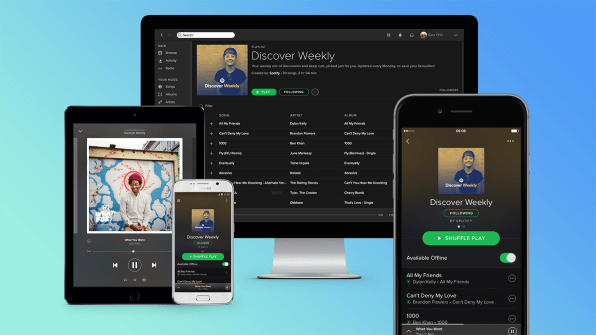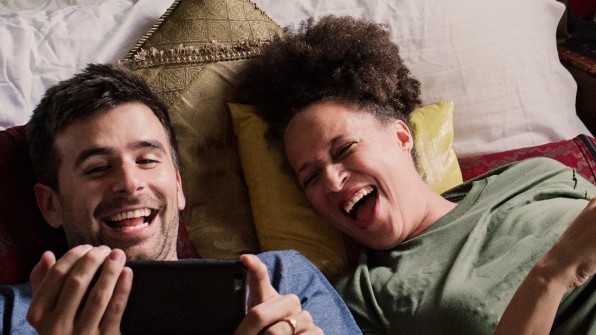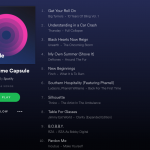Why Spotify Should Become A Social Network
This morning, before the coffee had set in, I tried to tap a “like” button that doesn’t exist. If you use Spotify a lot, perhaps you’ve had a similar moment: One of your friends pops up in the “friend activity” feed listening to one of your favorite bands. Or perhaps they’re going down a nostalgic rabbit hole and your immediate reaction is to mock them—lovingly, of course.
Spotify won’t let you “like” or comment on these things, though, because it’s not a social network. The music streaming service has some basic social features like an activity feed chronicling friends’ recent listens, as well as the ability to “follow” artists (whatever that means), but that’s about it. With a few more features and design tweaks, Spotify could easily become a social network for music. It totally should.
I know what you’re thinking: Another godforsaken social network? Don’t we have enough apps vying for our fractured attention spans and turning dopamine hits into ad dollars? Indeed, there are few things less exciting or inspiring than some existing tech product tacking on social features or worse, a trio of twentysomethings in Silicon Valley launching the next “Facebook killer” or photo-sharing app as though it’s not going to go belly-up or get sold for parts in 18 months.
But Spotify is different. The service already has the most important (and hardest to build) part of a social network: people. One hundred and forty million of them. More than 50 million of Spotifers pay for the premium version, which means they’re using Spotify on their phones, where the battle for people’s attention rages most intensely. Spotify also has some of the building blocks in the form of its basic social features. Now it just needs to build out the rest of it. Not just so I can like my friends’ ’90s alt-rock binges, but because it could offer a huge advantage to Spotify as it fends off competitors like Apple, Google, and Amazon.

I recently came across a Medium post calling for Spotify to build a Snapchat-style “Stories” feature into its app. The author’s proposal, illustrated with realistic-looking mockups, suggests that Instagram Stories should let you glance back at the last 24 hours of your friends’ listening activity. While I’m not convinced the world needs yet another Stories copycat (I can barely keep up with this feature on Instagram, let alone Facebook or Snapchat), I agree wholeheartedly with the spirit: Social features like that would make Spotify more engaging.
For starters, Spotify could make its friend activity stream more interactive and bring it to the mobile app (it has long existed only on the desktop interface). Let people like and interact with each other’s listens, share songs, playlists, and albums more easily (perhaps in that Stories-like format), and post things to one’s activity feed (like free-form text statuses or images), rather than just showing the last song you listened to. As Spotify invests in more original video series like Traffic Jams and lures listeners with podcasts, a user-curated stream à la Twitter or Facebook could be a powerful way to help all this new content rise above the noise.
Messaging could also be huge. Earlier this year, Spotify removed its native messaging and inbox feature, citing low engagement. But rather than kill it, why not build it out? A well-designed, prominently placed (perhaps with optional push notifications) private music-sharing and chat feature could keep people’s eyeballs affixed to the Spotify app, rather than sending them off to Facebook Messenger or a text message when they want to share songs. Spotify could take a cue from Instagram here: By integrating its direct message feature into the new Instagram Stories (making it the default way to reply to a Stories post), Instagram has seen its own native messaging usage explode. Again, that means people are staying in the Instagram app, rather than going to other channels to communicate.
These are just a few, fairly obvious possibilities. There are undoubtedly more. A more social Spotify doesn’t need to be bloated with excessive bells and whistles. It just needs to do enough to facilitate more sharing, discussion, and interaction around music. Music is an inherently social art form. We listen together, go to concerts together, and talk about that new SZA album at the office.

[Photo: courtesy of Spotify]
It’s not just about enabling fans to interact more with one another. Artists use Spotify too. The company has gone to great lengths in recent months to make its platform a far more useful place for musicians, opening up its Spotify for Artists analytics dashboard and giving artists more control over their profiles. The logical next step here would be to let artists post status updates, tease new music, and share their favorite songs with fans (something they can already do by creating playlists). Again, look at Instagram: Most of the top-followed people there are pop stars, who use the app to broadcast their days, share their work, and announce upcoming tours and albums (or babies). It’s an organic, personal-feeling connection that tightens the bond between artists and fans. For Instagram, this music-oriented use case sprung up organically on a social platform that originally had nothing to do with music. It just so happens that people really care about music, and Instagram is home to a ton of people—including artists. So imagine if such a fan-to-artist relationship were re-created on a platform that is literally made of music.
Why does this all of this matter? The competition, for one thing. We already know that Apple, now Spotify’s fiercest competitor, is not good at social. Ping, the music social network it tacked onto iTunes in 2011, remains one of Apple’s most memorable flops. Even the “connect” tab in Apple Music, originally touted as a place to follow and interact with artists, was scaled back in last year’s redesign of the service. Rdio had some decent social features, but the service never grew beyond a few million listeners before being acquired and shut down by Pandora in 2015. To date, nobody has nailed social music, especially at scale. But Spotify could.
If designed and executed well, a more social version of Spotify could be exponentially more addictive for frequent users. It could create a valuable FOMO effect: All my friends are sharing and talking about music on Spotify? Chance the Rapper is there too? Damn, I’d better sign up. With just the right amount of social activity—being cautious not to overdo it—Spotify would be practically guaranteed to see a significant boost in oft-coveted engagement metrics. Most importantly, all that extra tapping, typing, and screen-staring would inevitably lead to more of the most important metric of all: song streams.
With its long-rumored public offering reportedly in the works for later this year, Spotify has more than enough to focus on at the moment. But with Apple and Amazon gaining steam, a push toward a more social platform may be worth a shot. In the meantime, I’ll be over on Facebook, doing my best to break up the Trump headlines and fidget spinner memes with this hot new track. I hope somebody notices.
We know: The last thing the world needs is another social app competing for our brain space. But hear us out. There’s a good reason for this one.
This morning, before the coffee had set in, I tried to tap a “like” button that doesn’t exist. If you use Spotify a lot, perhaps you’ve had a similar moment: One of your friends pops up in the “friend activity” feed listening to one of your favorite bands. Or perhaps they’re going down a nostalgic rabbit hole and your immediate reaction is to mock them—lovingly, of course.
Fast Company , Read Full Story
(52)











